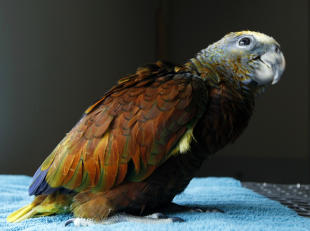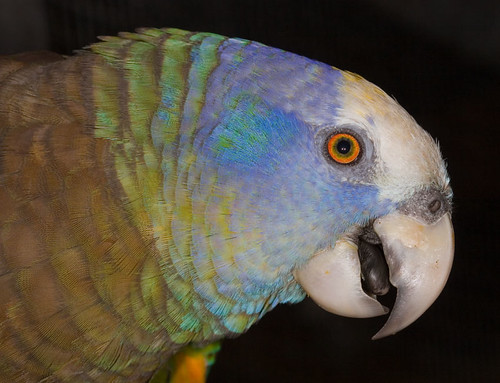tags: conservation, captive breeding, Houston Zoo, St. Vincent Parrot, St. Vincent Amazon, Guilding's Amazon parrot, Amazona guildingii, ornithology
The Houston Zoo in Houston, Texas, successfully hatched another endangered St. Vincent Amazon parrot, Amazona guildingii, on 28 May 2008. The young parrot was the third of this species to hatch at the Houston Zoo, which is the only zoo in the United States to successfully breed this species in captivity. The chick was named Vincent after the father of the first St. Vincent amazon parrot that was hatched at the Houston Zoo on 25 April 1972.
 "The chick [pictured, right] hatched after 25 days of incubation and is being hand raised at the Zoo's off exhibit Avian Conservation Environment (ACE) building," said Houston Zoo Bird Department supervisor Chris Holmes. "For the first 28 days Vincent was hand fed every two hours from 5 in the morning until midnight. He went home with me in the evening and came to work with me every morning," said Holmes, who is Vincent's mother. Vincent was transported in a specially made climate controlled carrier.
"The chick [pictured, right] hatched after 25 days of incubation and is being hand raised at the Zoo's off exhibit Avian Conservation Environment (ACE) building," said Houston Zoo Bird Department supervisor Chris Holmes. "For the first 28 days Vincent was hand fed every two hours from 5 in the morning until midnight. He went home with me in the evening and came to work with me every morning," said Holmes, who is Vincent's mother. Vincent was transported in a specially made climate controlled carrier.
The St. Vincent amazon is found only on a small Caribbean island known as St. Vincent, which is just 11 miles wide and 18 miles long, and is located northeast of Venezuela and west of Barbados. Because they have a wild population estimated at only 800 individuals, the species was officially classified as endangered in 1970 by the International Union for the Conservation of Nature (IUCN). The population of this species was seriously harmed by two natural disasters that struck the islands after 1898: a devastating hurricane followed by the eruption of the La Soufriere volcano found on the birds' home of St. Vincent. Because this species has a slow reproductive rate, rebuilding the population takes a long time.
 Amazon parrots are a group of stocky, medium-sized neotropical parrots. They have short, slightly rounded tails, broad and rounded wings, and heavy decurved bills with a distinct notch on the upper mandible. The St. Vincent parrot, the largest of the Amazona, is unique because it has three different color morphs.
Amazon parrots are a group of stocky, medium-sized neotropical parrots. They have short, slightly rounded tails, broad and rounded wings, and heavy decurved bills with a distinct notch on the upper mandible. The St. Vincent parrot, the largest of the Amazona, is unique because it has three different color morphs.
As the youngest representative of his species in captivity, when he reaches 80 days of age, Vincent will be moved to a cage that is off-site, next to his older sister and her mate.
"It's for socialization," Holmes points out. "Vincent has to learn how to be a bird."
Video of Vincent being handfed. Video by Julio Cortez, July 22, 2008. [1:02]
Vincent's parents will be on public exhibit again by early August, after the birds' breeding season has ended.
Sources
Houston Zoo press release (quote, video).
Houston Chronicle (quote).


Awww, cute.
What a beautiful baby! Gorgeous photo at the top too.